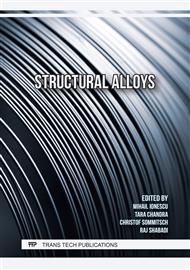[1]
J.H. Hollomon, Tensile deformation, Aime Trans 12(4) (1945) 1-22.
Google Scholar
[2]
P. Ludwik, Elemente der technologischen Mechanik, Springer1909.
Google Scholar
[3]
E. Voce, The relationship between stress and strain for homogeneous deformation, J. Inst. Met. 74 (1948) 537-562.
Google Scholar
[4]
E. Voce, A practical strain hardening function, Metallurgia. 51 (1955) 219-226.
Google Scholar
[5]
Y. Bergström and H. Hallén, An improved dislocation model for the stress-strain behaviour of polycrystalline α-Fe, Mater. Sci. Eng. 55 (1982) 49-61.
DOI: 10.1016/0025-5416(82)90083-0
Google Scholar
[6]
Y. Bergström, The plastic deformation of metals - A dislocation model and its applicability, Rev. powder Metall. Phys. Ceram. 2/3 (1983) 79-265.
Google Scholar
[7]
Y. Bergström, A dislocation model for the stress-strain behaviour of polycrystalline α-Fe with special emphasis on the variation of the densities of mobile and immobile dislocations, Mater. Sci. Eng. 5 (1970) 193-200.
DOI: 10.1016/0025-5416(70)90081-9
Google Scholar
[8]
S.D. Yadav, V. Vijayanand, M. Nandgopal, G. Prasad Reddy, On the tensile flow stress response of 304 HCu stainless steel employing a dislocation density based model and electron backscatter diffraction measurements, Philosophical Magazine 100 (2020) 312-336.
DOI: 10.1080/14786435.2019.1680887
Google Scholar
[9]
A.S. Joseph, P. Gupta, N. Kumar, M.C. Poletti, S.D. Yadav, An advanced dislocation density-based approach to model the tensile flow behaviour of a 64.7 Ni–31.96 Cu alloy, Philosophical Magazine 102 (2022) 1481-1504.
DOI: 10.1080/14786435.2022.2056645
Google Scholar
[10]
L.-E. Lindgren, Q. Hao, D. Wedberg, Improved and simplified dislocation density based plasticity model for AISI 316 L, Mechanics of Materials. 108 (2017) 68-76.
DOI: 10.1016/j.mechmat.2017.03.007
Google Scholar
[11]
M. Fisk, J.C. Ion, L.-E. Lindgren, Flow stress model for IN718 accounting for evolution of strengthening precipitates during thermal treatment, Computational materials science. 82 (2014) 531-539.
DOI: 10.1016/j.commatsci.2013.10.007
Google Scholar
[12]
A. Malmelöv, M. Fisk, A. Lundbäck, L.-E. Lindgren, Mechanism based flow stress model for alloy 625 and alloy 718, Materials. 13 (2020) 5620.
DOI: 10.3390/ma13245620
Google Scholar
[13]
D.L. Holt, Dislocation cell formation in metals, J. Appl. Phys. 41(1970) 3197-3201.
Google Scholar
[14]
E. Nes, Modelling of work hardening and stress saturation in FCC metals, Progress in materials science. 41(1997) 129-193.
DOI: 10.1016/s0079-6425(97)00032-7
Google Scholar
[15]
B. Rath, M. Imam, C. Pande, Nucleation and growth of twin interfaces in fcc metals and alloys, Mater. Phys. Mech. 1 (2000) 61-66.
Google Scholar
[16]
L. Gypen, A. Deruyttere, Multi-component solid solution hardening: Part 1 Proposed model, Journal of Materials Science. 12 (1977) 1028-1033.
DOI: 10.1007/bf00540987
Google Scholar
[17]
Chen, T., 2020. Understanding the deformation mechanisms in Ni-based superalloys with using crystal plasticity finite element method. Missouri University of Science and Technology.
Google Scholar
[18]
G.Z. Voyiadjis, Y. Song, A physically based constitutive model for dynamic strain aging in Inconel 718 alloy at a wide range of temperatures and strain rates, Acta Mech. 231 (2020) 19-34.
DOI: 10.1007/s00707-019-02508-6
Google Scholar
[19]
M. Moiz, PhD thesis, The influence of grain size on mechanical properties of Inconel 718, 2013.
Google Scholar



